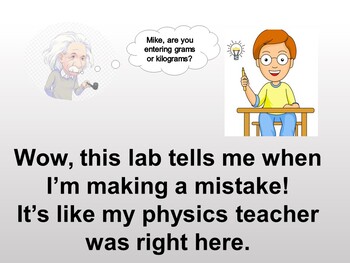6 Do At Home Physics Labs
- Zip
- Excel Spreadsheets
Description
These labs can be performed in school or at home with or without partners.
Equipment needed: m&m’s; cell phone or watch w stopwatch function, clay or Play Dough; small stones; a marble or a golf ball; a couple of rulers or small sticks; a 2-foot board or cookie baking sheet; 2 books or boards to slap together to make a loud noise.
Included are:
1. Measuring the acceleration of gravity. Drop stones out of a second story window or
down a stairwell and measure fall times with stopwatch on a cell phone.
2. Radioactive Decay and Half-Life. Measure the “decay” of m&m’s.
3. Speed of Light from Cheese. Heat cheese in a microwave, measure distance
between melt/burn spots, calculate speed of light.
4. Speed of Sound from Echo. Make a loud noise directed at a masonry building and
measure the time between the sound and its echo with stopwatch on a cell phone.
5. Potential and Kinetic Energy. Roll a marble or golf ball down a ramp, across a table,
and have it land on a clay pancake. This lab requires clay or Play Dough; the ramp
can be made by taping 2 rulers onto a 2-foot board or onto a cookie baking sheet.
Instructions for making the ramp are in the lab.
6. The Pendulum Lab. The pendulum consists of a thread attached to a tack or
pushpin stuck over an open doorway. The masses can be house keys or large
washers. Students determine the dependence of period on mass, release angle,
and string length. The last segment has the pendulum going in a circle rather
than back and forth.


